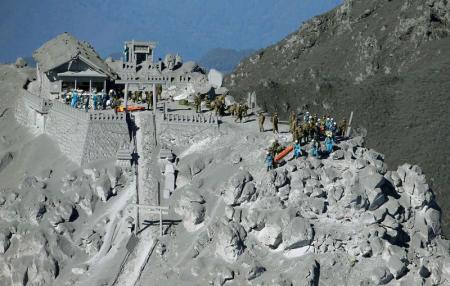By Elaine Lies
TOKYO (Reuters) – More than 500 rescuers in Japan resumed searching on Monday for victims of a volcano that erupted without warning at the weekend, leaving four confirmed dead and 27 presumed to have perished in a sudden rain of ash and stone.

Searchers headed for the summit of Mount Ontake, turned into an eerie moonscape by a thick layer of grey ash, where most of the victims of Japan’s first fatal volcanic eruption since 1991 are believed to have fallen near craters spewing steam and ash.
There’s been absolutely no contact at all, one man waiting for news of a family member told NHK national television. We’re utterly exhausted.
Four men were pronounced dead late on Sunday, a day after the 3,067-metre (10,062-feet) volcano, a popular hiking spot crowded with climbers admiring the fall foliage, erupted in a massive cloud of ash and smoke. Forty people were injured.
The other 27 believed dead were described as having suffered cardiopulmonary arrest, a procedural formality followed in Japan in the absence of a medical examination to confirm death.
Rescue efforts were abandoned on Sunday after the smell of sulphur strengthened at the peak, fanning fears of toxic fumes.
Japan is one of the world’s most seismically active nations, but had suffered no fatalities in volcanic eruptions since 1991, when 43 people died in a pyroclastic flow, a superheated current of gas and rock, at Mount Unzen in the southwest.
Ontake, Japan’s second-highest active volcano, 200 km (125 miles) west of Tokyo, last had a minor eruption seven years ago. Its last major eruption, the first on record, was in 1979.
Hikers said there was no warning of Saturday’s eruption just before noon on a clear day on a peak crowded with visitors, including children. Hundreds were trapped for hours before descent became possible later in the day.
It was natural that Japan’s Meteorological Agency, which monitors volcanic activity, might reconsider its surveillance system, said Chief Cabinet Secretary Yoshihide Suga.
However, I believe that, given current levels of knowledge, they made the only judgement they could, he told a news conference.
Suga also said the eruption would have no impact on the restart of the Sendai nuclear plant in southwestern Japan, an area of active volcanic sites. The plant was just cleared to restart in early September.
Experts said it was hard to have predicted the eruption, despite tremors in the area this month, since there were no other changes in the mountain.
Also, the eruption appears to have resulted from a steam-driven explosion of a kind that is especially hard to forecast, said Toshitsugu Fujii, a volcano expert.
They often occur quite suddenly and there is absolutely no guarantee that the earthquakes earlier this month were connected, he told a news conference on Sunday. There is no guarantee of total safety when you’re dealing with nature.
(This version of the story corrects date of eruption to Saturday in paragraph 9)
(Additional reporting by Kaori Kaneko; Editing by Clarence Fernandez)





